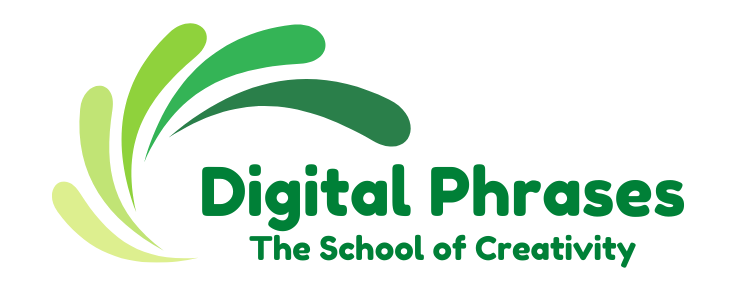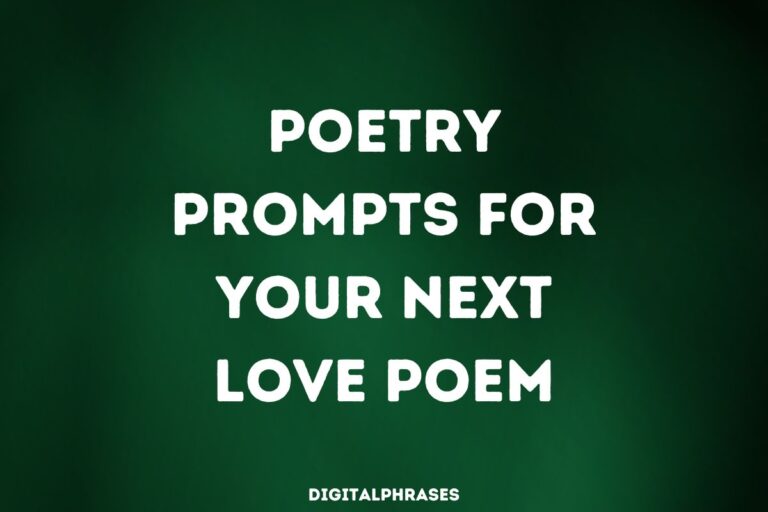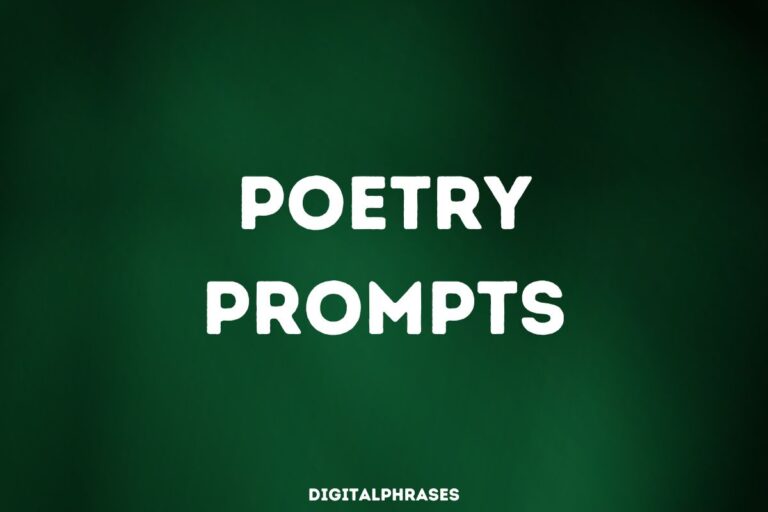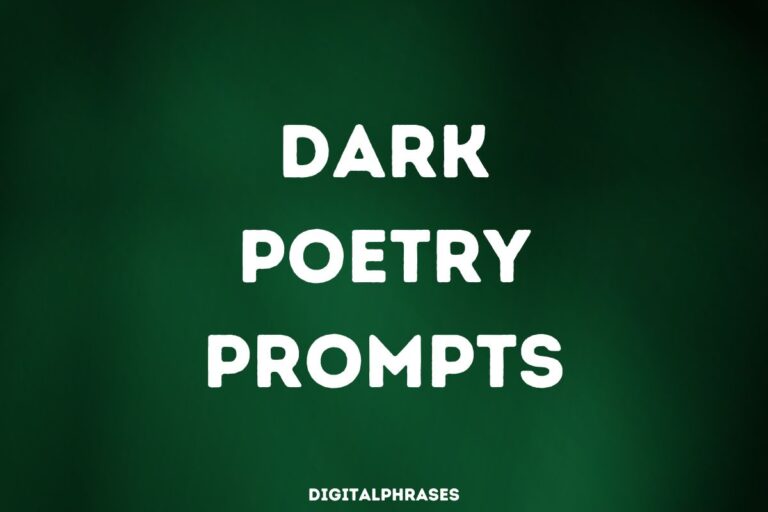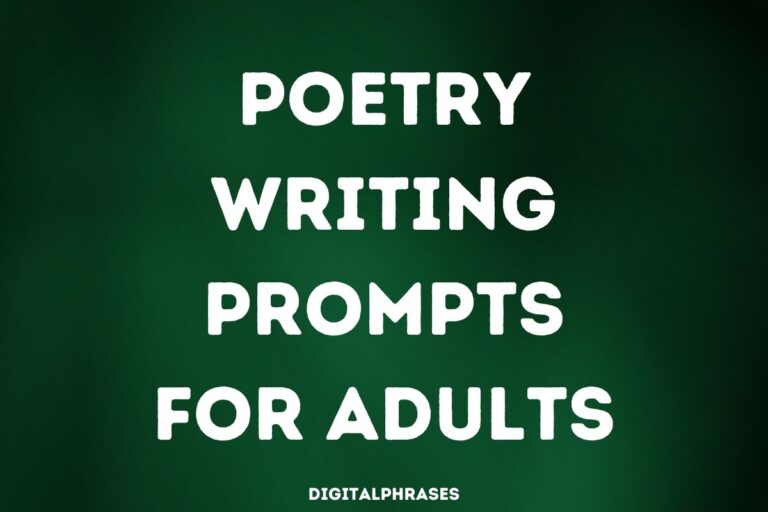24 Writing Prompts for Poetry Analysis
Poetry is pretty amazing, right?
It can take you on a feels trip deep into someone’s heart and mind. We get to see cool pictures the poet creates with words, and sometimes there are hidden meanings they snuck in too.
But hold on, there’s more to poems than just reading them once.
Analyzing poetry is like being a detective! We crack the code to find the secret messages and figure out what the poet was really trying to say.
So, whether you’re a bookworm or just like reading sometimes, these prompts will help you become a poetry pro.
You’ll start seeing poems in a whole new light, and maybe even enjoy them more!
Let’s get started on this poetic adventure together!
Writing Prompts for Poetry Analysis
The Evolution of a Poet’s Voice: As poets grow, so does their style, influenced by personal experiences, global events, and evolving perspectives. Dive deep into the works of a single poet from their early days to their later years. Compare the transformation in their voice, imagery, and themes. What shifts can you identify and how can you relate this evolution to their life’s journey?
Cultural Undercurrents in Poetry: Poetry often mirrors the societal and cultural aspects of the era it’s penned in. Select a poem that has been written during a significant historical period. Analyze how the poem reflects the cultural and societal nuances of its time. How does the poet’s choice of words, style, and themes convey the prevailing sentiments?
Nature’s Influence on Poetic Imagery: Nature has always been a potent inspiration for poets across eras and geographies. Choose a poem that vividly draws from nature, whether it’s the landscape, seasons, or wildlife. Examine how the poet uses nature not just as a backdrop but as a metaphor or symbol to weave deeper meanings into their verses.
Interplay of Light and Dark in Poetry: Contrasts, especially that of light and darkness, offer a rich tapestry for poets to draw from. Focus on a poem that prominently features these elements. Explore how the poet plays with the themes of light and dark – is it merely a visual element, or does it allude to deeper emotional or philosophical contrasts?
The Dance of Rhythm and Meaning: Poetry is as much about sound and rhythm as it is about words and meaning. Select a poem where the meter and rhythm play a significant role. Analyze how the rhythm enhances or alters the interpretation of the poem’s content. Does the rhythm serve the message, or does it introduce a new layer of meaning?
Personal to Universal: The Broadening Circles of Empathy: Many poems start with a deeply personal experience but resonate with universal truths. Choose such a poem and explore how the poet moves from the individual to the collective experience. How do they craft their verses to make their personal narrative relatable to a wider audience?
Poetic Responses to Art and Music: Sometimes, poets are inspired by other forms of art – a painting, a sculpture, a piece of music. Find a poem that is a direct response to or inspired by another art form. Delve into how the poet translates visual or auditory experiences into words. How do they capture the essence and emotions of the original art?
The Power of Unsaid in Poetry: Poetry often thrives in the spaces between words, in the unsaid and the implied. Choose a poem that employs this technique of leaving things unsaid. Investigate what is omitted and the impact of this omission. How does the poet create a powerful resonance through what they choose not to say?
The Intersection of Modernity and Tradition: Across time, poets have grappled with the clash and confluence of the old and new. Find a poem that stands at this crossroads, discussing the nuances of progress and tradition. Assess how the poet reconciles or contrasts the past with the present, and what insights or critiques they offer on this juxtaposition.
The Role of Place and Setting in Eliciting Emotion: Landscapes, cities, and rooms often come alive in poetry, playing crucial roles beyond mere settings. Select a poem where a place or setting is integral. Examine how the poet imbues the location with emotion, transforming it into a character or a symbol that significantly influences the poem’s tone and meaning.
Exploring Duality through Poetic Structure: Many poems have a dual structure—whether in mirrored stanzas, contrasting tones, or parallel themes. Focus on a poem with a clear dual or mirrored aspect. Investigate how this structure complements or complicates the poem’s primary message. Does it create harmony, tension, or an intricate dance between the two?
Journey Through the Senses: More Than Sight and Sound: While many poems play with visual and auditory imagery, some delve into the less explored senses. Identify a poem that vividly evokes taste, touch, or smell. Analyze how the poet harnesses these senses to enrich the reader’s experience and immerse them in the described scene or emotion.
Portraits of the Self: Internal Landscapes in Poetry: Some poets turn inwards, creating intricate portraits of the mind and soul. Choose a poem that delves deep into the poet’s internal world. Explore the tools and metaphors they employ to map out their inner landscapes, and how this introspection adds layers to the poem’s external narrative.
Poetry as Political Commentary: Throughout history, poets have not shied away from commenting on political events, policies, and figures. Pick a poem with a clear political stance or message. Dissect how the poet weaves political critique or support into their verses, and the techniques they use to either subtly or overtly convey their position.
Navigating Transitions: Poems of Thresholds and Doorways: Life is punctuated by moments of transition—births, deaths, beginnings, and ends. Find a poem that captures such a transformative moment. Analyze the symbols and language the poet uses to depict thresholds, and how they communicate the emotions and implications of being in-between.
Human Connection in the Digital Age: In the modern world, technology has redefined relationships and human interaction. Unearth a poem that grapples with this digital evolution. Examine how the poet portrays the interplay between the tangible and virtual, and the challenges or opportunities this new form of connection presents.
Mythology Reimagined Through Contemporary Lenses: Myths, legends, and ancient tales have always influenced poets. Choose a poem that reinterprets or references a mythological story in a contemporary context. Probe into how the poet reshapes the myth to address modern issues or sensibilities, offering a fresh perspective on an age-old narrative.
The Delicate Dance of Desire and Restraint: Desire, in all its forms, often finds its voice in poetry. Select a poem that wrestles with the tension between longing and limitation. Examine how the poet captures the push and pull of passion, whether it’s romantic, existential, or another form of yearning.
The Poetic Exploration of Dreams and Reality: The realm of dreams offers a fertile ground for poets to explore the subconscious and the surreal. Focus on a poem that delves into dreams, either as wishful aspirations or nighttime visions. Assess how the poet navigates the boundary between dream and reality, blurring or accentuating the distinction.
Reflections on Time: The Ephemeral and the Eternal: Time, with its fleeting nature and eternal implications, is a recurring theme in poetry. Identify a poem that contemplates time’s passage. Analyze how the poet engages with concepts of temporality and permanence, and the emotions evoked by these reflections.
Voices of the Marginalized in Poetry: Throughout history, poetry has often been a medium for marginalized voices to express their truths and struggles. Choose a poem that provides a voice to the silenced or overlooked. Investigate the poet’s portrayal of their experiences and their call for acknowledgment or change.
The Poet’s Craft: Meta-Poetry and the Art of Writing: Meta-poetry involves poems about poetry itself, offering insights into the creative process. Select a poem that delves into the art of writing or the poet’s relationship with their craft. Examine how the poet uses self-reflection to discuss the challenges and joys of poetic expression.
The Fusion of Joy and Sorrow in Poetic Narratives: Emotions are multifaceted, and poets often capture the coexistence of joy and sorrow. Find a poem that intertwines these seemingly opposing feelings. Analyze the techniques the poet employs to showcase the duality of human emotions, and how they emphasize the richness of life’s experiences.
Navigating Identity in a Multicultural World: In an increasingly globalized world, questions of identity and belonging become complex. Choose a poem that grapples with the challenges of multicultural or hybrid identities. Delve into how the poet expresses their journey of self-discovery amidst multiple cultural influences, and the insights this offers into the broader human experience.
